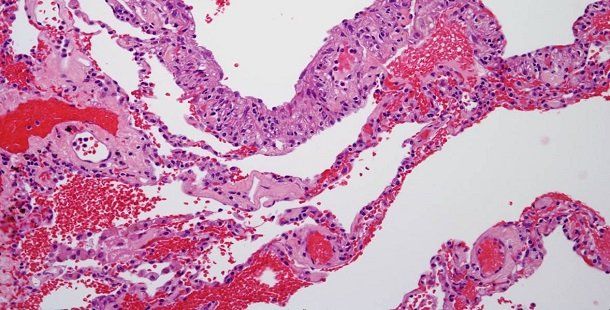Olaparib Combo Provides Meaningful Benefit in Uterine Leiomyosarcoma
Olaparib plus temozolomide appears to prolong median progression-free survival for those with homologous recombination deficient uterine leiomyosarcoma compared with homologous recombination proficient tumors.
"In summary, the combination of olaparib and temozolomide provided encouraging activity in pretreated [uterine leiomyosarcoma], an aggressive sarcoma subtype without an effective targeted therapy," according to the authors of a phase 2 study published in Journal of Clinical Oncology.

Combining olaparib (Lynparza) with temozolomide (Temodar) resulted in meaningful clinical benefit in a small population of patients with advanced uterine leiomyosarcoma previously treated with chemotherapy, according to findings from the phase 2 NCI Protocol 10250 study published in Journal of Clinical Oncology.
With a median follow-up of 22 months, 23% (n = 5/22) of patients achieved an objective response within 6 months of treatment, meeting the study’s primary end point. An additional patient responded to treatment after 11.5 months, resulting in an objective response rate of 27%. In terms of best objective responses, 6 patients had a partial response (PR), 9 had stable disease, 4 had progressive disease, and results were not evaluable in 3 patients. Among those with a PR, the median duration of response was 12.0 months (95% CI, 9.5-not evaluable [NE]).
Olaparib plus temozolomide produced a median progression-free survival (PFS) of 6.9 months (95% CI, 5.4-NE). The PFS rate was 65% at 6 months, 38% at 12 months, and 22% at 24 months. The median overall survival (OS) was not reached.
“In summary, the combination of olaparib and temozolomide provided encouraging activity in pretreated [uterine leiomyosarcoma], an aggressive sarcoma subtype without an effective targeted therapy,” the study authors wrote. “A randomized phase 2/3 clinical trial [NCT05633381] evaluating olaparib and temozolomide versus investigator’s choice of trabectedin [Yondelis] or pazopanib [Votrient] is underway.”
In the single-arm, open-label, multi-center phase 1/2 NCI Protocol 10250 trial, all patients received 75 mg/m2 of temozolomide orally once a day plus 200 mg of olaparib orally twice a day on days 1 to 7 of continuous 21-day cycles. Investigators performed imaging to assess disease status once every 6 weeks.
The primary end point was best objective response rate (ORR) per RECIST criteria; investigators considered the study regimen to be promising if at least 5 patients achieved a response. Secondary end points included overall ORR, median PFS, median OS, and safety. Determining whether SLFN11 or MGMT RNA expression correlated with clinical benefit was an exploratory objective.
Patients with locally advanced and unresectable or metastatic uterine leiomyosarcoma were eligible for enrollment on the study. Additional eligibility criteria included having an ECOG performance status no higher than 2 and disease progression following at least 1 line of systemic treatment for advanced disease.
The study included 22 eligible and evaluable patients who enrolled between August 2019 and February 2020. The median patient age was 55 years (range, 39-71). Most patients had an ECOG performance status of 1 (68%) and metastatic disease (77%). Additionally, most patients had received 3 or more prior lines of therapy (59%) and treatment with gemcitabine/docetaxel (86%).
Three patients with RAD51B, PALB2, and ATR alterations had a best response of stable disease and PFS of 31.5 months, 27.3 months, and 7.1 months, respectively. Among 2 patients with ATRX mutations, the best response of stable disease and PFS was 5.4 months and 2.7 months.
Assessment with the RAD51 foci formation assay in 18 pretreatment biopsies identified 9 homologous recombination repair deficient (dHRR) tumors and 7 HRR proficient (pHRR) tumors. In an exploratory Kaplan-Meier analysis, the median PFS was 11.2 months for those with dHRR tumors vs 5.4 months for those with pHRR tumors (P = .05).
Investigators identified no relationship between PFS and pretreatment levels of SLFN11 (HR, 0.98; 95% CI, 0.52-1.83; P = .90) or MGMT (HR, 1.12; 95% CI, 0.65-1.92; P = .70).
Common any-grade hematologic adverse effects (AEs) included neutropenia (90%), thrombocytopenia (86%), leukopenia (77%), and anemia (68%). Grade 3 hematologic AEs included neutropenia (59%), anemia (32%), and thrombocytopenia (14%).
Nonhematologic AEs included fatigue (54%), nausea (54%), constipation (32%), anorexia (27%), vomiting (22%), diarrhea (18%), and dry skin (14%). Grade 3 events of nausea, rash, and diarrhea occurred in 1 patient each.
Reference
Ingham M, Allred JB, Chen L, et al. Phase II study of olaparib and temozolomide for advanced uterine leiomyosarcoma (NCI Protocol 10250). Published online July 19, 2023.J Clin Oncol. doi:10.1200/JCO.23.00402
Sarcoma Awareness Month 2023 with Brian Van Tine, MD, PhD
August 1st 2023Brian Van Tine, MD, PhD, speaks about several agents and combination regimens that are currently under investigation in the sarcoma space, and potential next steps in research including immunotherapies and vaccine-based treatments.